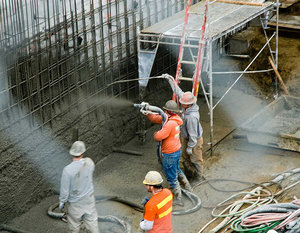

Temporary Support Systems
Temporary support is defined as any system designed and installed to support the perimeter of an underground opening between the time it is first excavated up to the time that a permanent lining is in place.
We can divide these supports into 4 main categories :
-
Support acting by applying a confining pressure to the surrounding ground
- shotcrete
- shotcrete with lattice girders
-
Support applying both a confining pressure and acting as reinforcement of the surrounding ground
This type of support includes various types of rock bolts:- ungrouted mechanically or chemically anchored rock bolts
- grouted (resin or mortar) rock bolts
- driven anchor bars
-
Systems providing plain "brute strength” support
- heavy steel ribs
- lattice girders
- steel linings
- concrete segments
- driven tubes (umbrella arch)
- shields
-
Systems which consolidate the ground to amend its geotechnical and/or hydrological properties
- consolidation grouting
- compressed air
- freezing
Permanent support
Permanent support is defined as the support that is designed and installed to guarantee the long term stability of the underground structure.
On some occasions, the permanent support is taken into consideration for the long term, being considered in such case also as permanent support. This is the case of precast concrete segments placed by TBMs or certain rockbolts.
Other temporary support elements might suffer degradations over time (corrosion on steel rockbolts, loosening of sprayed concrete, etc) and therefore their contribution is often neglected for the long term.
In these occasions, permanent support is normally guaranteed by means of a concrete shell that is cast in place with movable formworks.
Sometimes, permanent support also plays an important functional role. This can be the case of traffic tunnels (smooth surfaces needed for ventilation, visibility and esthetic qualities), or hydraulic reasons (smooth surfaces for less hydraulic charge losses).
